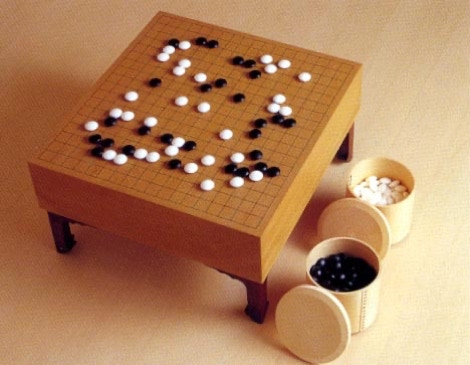games
Go
This board game, played with black and white stones, came to Japan from China in the eighth century. It is still played today. Requiring the strategic maneuvers of chess, it is considered an intellectual game. Even priests, who were forbidden most amusements, were allowed to play go.

Sukeroku
If the cerebral interest of go can be compared to chess, the simple competitive fun of sukeroku is more like backgammon, which this game resembles in form. The retired Emperor Shirakawa (r.1072-1086) was an enthusiast who famously remarked that there were three things in life he could not control: the waters of the Kamo River, the priests on Mt. Hiei, and the roll of the sukeroku dice. In The Tale of Genji, the character known as the Omi Lady is depicted playing sukeroku with another lady. As she rattles the dice in her hand, praying loudly for a lucky roll, she is glimpsed by her father, Prince Genji's friend To no Chūjō. He is appalled at her boorish manners.
Cockfighting
Cockfighting, sometimes called tori awase, “comparing birds," was usually done in teams—the team of the left versus the team of the right. There is a scene in The Tale of Murasaki, the chapter entitled "Pent-up Waters," where Murasaki's brother Nobunori has just come from a cockfight sponsored by retired emperor Kazan. Kazan gets angry when the cocks picked for his favorite son's team keep losing—a detail picked from the historical record, noted in the Eiga Monogatari. Cockfighting was enjoyed by aristocrats and commoners alike.
Kemari
An outdoor group sport played by young men, kemari in principle was rather like hackysack. The idea was to kick a light, hollow ball made of deerskin into the air and alternate turns in kicking to keep it aloft. The four corners of the playing yard were planted with willow, cherry, pine, and "cockscomb tree" (a kind of maple) to define the positions. For example, the play would always start from the position under the pine tree. Played with loose rules as a genuine sporting competition at first, by the twelfth century kemari had become highly ritualized.
